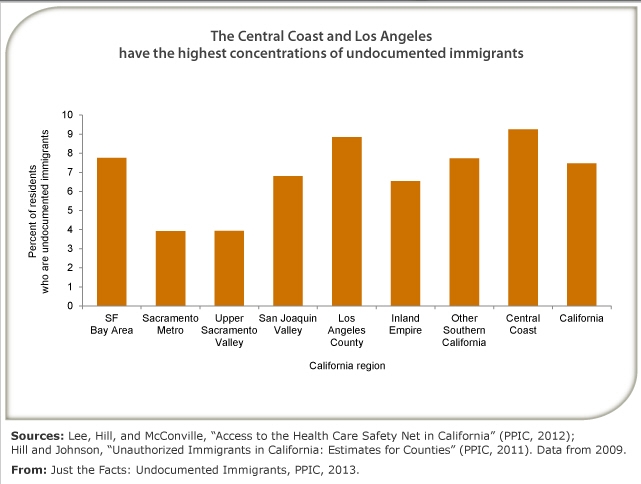Apr 8, 2013
The Public Policy Institute of California published recently a fact sheet which indicates that California is home to more than two million undocumented immigrants. This short piece offers facts and figures about where these immigrants come from, where they live, what kinds of work they do, and more. The PPIC site also offers two maps that illustrate the geographic distribution of undocumented immigrants for all zip codes in California.
- California is home to more than two million undocumented immigrants.
No representative national or state surveys provide an accurate direct count of undocumented (also known as illegal or unauthorized) immigrants, but the best estimates suggest that in 2010 California was home to about 2.6 million undocumented immigrants. Almost a quarter (23%) of the nation’s undocumented immigrants reside in California—by contrast, the state’s share of the nation’s overall population is only about one-eighth. In Nevada, California, and Texas, undocumented immigrants constitute about 7% of the population, the highest concentration in the United States. - After a brief decline, the population of undocumented immigrants in the U.S. has stabilized.
Between 1990 and 2007 the undocumented population increased more than threefold, from less than 4 million to about 12 million. It dropped to about 11 million in 2009 and has since been relatively stable, according to estimates by the Department of Homeland Security and the Pew Hispanic Center. - Most undocumented immigrants are from Latin America.
Nationwide, eight of every ten undocumented immigrants are from Latin America—and more than half (58%) are from Mexico alone. Most of the remainder is from Asia, though Europe, Canada, and Africa account for hundreds of thousands of undocumented immigrants in the United States. As of 2010, the share of undocumented immigrants from Mexico has declined somewhat, probably due to a decrease in new undocumented immigrants from Mexico and increased deportations of Mexican undocumented immigrants. - Undocumented immigrants often live with relatives who are legal U.S. residents.
Nearly half of undocumented immigrants in the U.S. are parents of minor children, and most of these children (77%) are U.S. citizens. While about 4.5 million children in 2010 had at least one undocumented parent, only 1 million children under 18 were themselves undocumented immigrants. As many as 1.7 million undocumented young (under 30) immigrants could be eligible for U.S. Department of Homeland Security’s Deferred Action for Childhood Arrivals (DACA) program, and more than 25% of the DACA-eligible are in California. - More undocumented immigrants live in Los Angeles County than any other California region.
Los Angeles County has the highest number of undocumented residents (nearly 900,000) of any area in the state, followed by Orange County (nearly 300,000), San Diego County (close to 180,000) and Santa Clara County (more than 170,000). The San Francisco Bay Area, Central Coast, and San Joaquin Valley have substantial populations of undocumented immigrants. And undocumented immigrants live in nearly every county of the state. - About one in ten workers in California is an undocumented immigrant.
California’s labor force includes about 1.85 million undocumented immigrants—along with Nevada, it has the highest statewide concentration of undocumented workers (10%) in the U.S. Undocumented immigrants work disproportionately in the farming, construction, production, services, and transportation/materials moving industries. - A record share of Californians back a path to legal status.
According to a January 2013 PPIC Statewide Survey, a record-high 76% of Californians—including majorities across parties—say that "illegal immigrants who have lived and worked in the United States for at least two years should be given a chance to keep their jobs and eventually apply for legal status”—21% say these immigrants should be deported.
Source: Published originally on Public Policy Institute of California as Undocumented Immigrants by Laura Hill and Joseph Hayes, February 2013.
By Laura Hill and Joseph Hayes, Public Policy Institute of California
Author - Administrative Assistant III
Author - Administrative Assistant III
